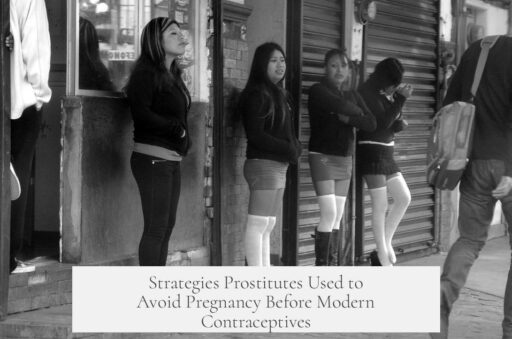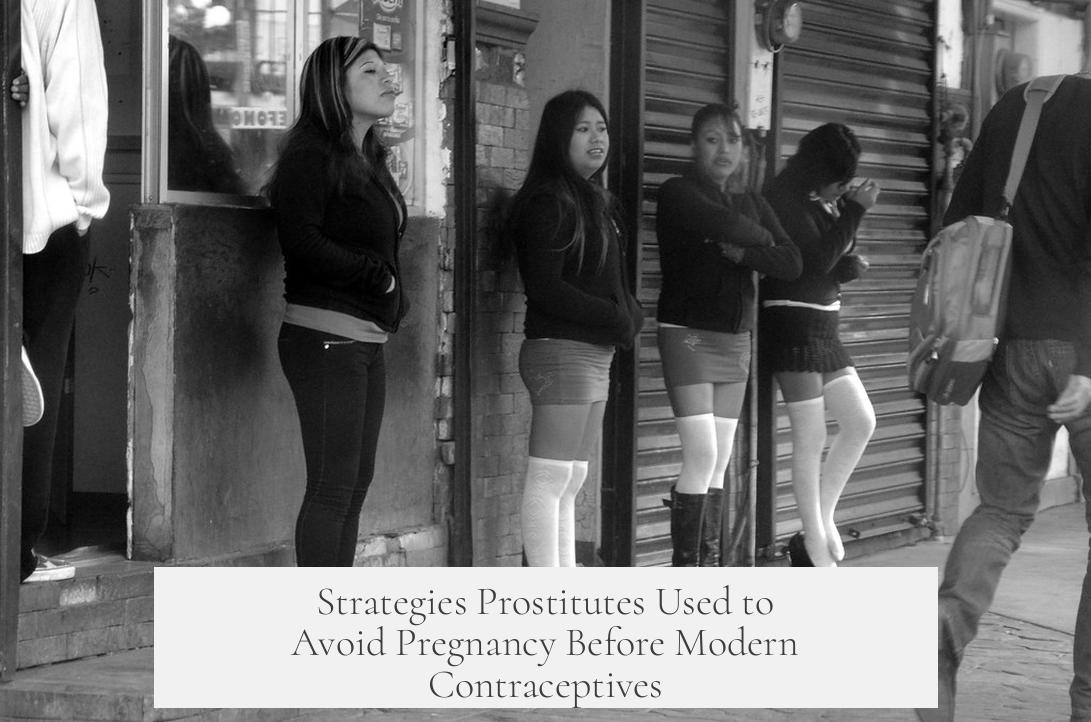Prostitutes before modern contraceptives employed a range of methods to prevent or manage pregnancy, though these were often unreliable and sometimes dangerous.

Pregnancy prevention was imperfect. Many prostitutes did become pregnant despite precautions. Historical examples, such as Nell Gwynn—born in 1650 London to a prostitute—illustrate this reality.
Biological and environmental factors naturally reduced fertility for many women in prostitution. Poverty and poor nutrition delayed puberty, thus shortening reproductive years. Malnutrition, stress, and hunger further suppressed fertility temporarily or permanently. Sexually transmitted diseases, common in prostitution, frequently caused infertility or pregnancy complications. For instance, chlamydia and pelvic inflammatory disease often destroyed fertility, while syphilis increased miscarriage risk and could cause sterility over time.

Avoiding penetrative sex acted as a practical preventive method for some prostitutes. Not all engaged in vaginal intercourse, often due to client preference or fear of disease transmission. Diaries from the 17th century note men requesting non-penetrative acts to reduce STD risk. This strategy, though limited in scope, helped prevent pregnancy.
Deliberate miscarriage through folk remedies formed another method, despite health risks. Various herbs and substances were believed to induce abortion, though their efficacy and safety were questionable. Patent medicines marketed as “female complaint cures” sometimes aimed to cause miscarriages. Additionally, violence from pimps or clients occasionally resulted in miscarriage, reflecting the harsh realities faced.

Evidence for contraceptive devices is limited but notable. Some historical documents from 14th-century France and the French Revolution mention barrier-like methods inserted into the vagina, possibly covering the cervix similar to modern diaphragms. The exact nature and effectiveness of these devices remain uncertain. Nevertheless, they could have offered some protection.
Miscarriages and high infant mortality were common outcomes, partly due to stress, violence, and poor living conditions. These factors contributed to both natural and induced pregnancy loss. Even queens of the era experienced frequent miscarriages, showing biological vulnerability beyond social class.

When pregnancies reached term, post-pregnancy actions were often drastic. In ancient societies, brothel owners legally abandoned newborns. Later societies saw infant killing, abandonment, or placement in foundling hospitals. These institutions cared for many thousands of children abandoned during the 17th and 18th centuries. Mothers sometimes left tokens on infants, hoping to reclaim them later, though most children remained in institutional care or died young.
| Prevention/Management Method | Description | Effectiveness and Risks |
|---|---|---|
| Delayed puberty & malnutrition | Poverty delayed reproductive maturity; poor nutrition reduced fertility | Lower overall fertility but uncontrolled |
| STD-induced infertility | Sexually transmitted diseases damaged reproductive organs | Reduced fertility; increased miscarriages |
| Avoidance of penetrative sex | Non-penile-vaginal intercourse to avoid pregnancy | Limited but effective prevention |
| Folk remedies and abortifacients | Herbs and drugs to induce miscarriage | Variable success; dangerous health risks |
| Violence-induced miscarriage | Physical abuse causing pregnancy loss | Unintended and violent |
| Barrier contraceptive devices | Primitive devices covering cervix | Poorly documented; possibly limited effect |
| Infant abandonment or killing | Exposure, neglect, or foundling homes | High infant mortality and societal response |
The historical methods highlight the vulnerability of prostitutes to unwanted pregnancies and limited options to control fertility. These strategies combined natural biological factors, behavioral adaptations, and harmful practices.

- Poverty and poor health limited fertility but did not prevent pregnancy.
- Sexually transmitted diseases contributed significantly to infertility and pregnancy loss.
- Avoidance of vaginal intercourse reduced pregnancy risk for some women.
- Folk abortifacients were known but risky and unreliable.
- Primitive contraceptive devices existed but were not widespread or clearly effective.
- High miscarriage and infant mortality rates prevailed among prostitutes.
- Infant abandonment and killing were societal responses to unwanted births.
How Did Prostitutes Prevent Themselves from Getting Pregnant Before Contraceptives?
Simply put, before modern contraceptives, prostitutes employed a mix of biological luck, risky practices, and grim choices to dodge pregnancy—but success was far from guaranteed. It’s a story of survival shaped by harsh realities and limited options. Let’s unravel how this shadowy side of history worked.

First off, it’s critical to understand that pregnancy prevention was more a game of chance than science. Prostitution has ancient roots, yet preventing pregnancy without reliable contraceptives was a constant struggle. Women often got pregnant despite their best efforts. Nell Gwynn, a famous 17th-century London actress and the daughter of a prostitute, is a perfect example. Born in 1650, her existence reminds us that pregnancies did happen regardless of precautions—or attempts at them.
The Biological and Environmental Wildcards

Poverty wasn’t just a social label—it shaped women’s biology in ways that could unintentionally reduce fertility. Poor nutrition and chronic stress delayed puberty among many women in prostitution. Without proper nourishment, puberty might push back by years, shrinking the fertile window. Less fertile years meant fewer chances to conceive naturally. Sounds like nature’s own birth control, right?
But that’s just the start. Malnutrition and physical stress could cause temporary infertility. Extreme hunger and anxiety interfered with ovulation cycles. On top of this, sexually transmitted diseases (STDs) riddled many women’s bodies, often attacking reproductive organs. Chlamydia and pelvic inflammatory disease (PID) could cause irreversible infertility, while syphilis not only threatened fertility but led to miscarriages and stillbirths. So, infections had an ironic ‘side effect’ of pregnancy prevention.
Dodging Penetrative Sex — The Tried and True?
Not all prostitution involves full intercourse. Historical diaries, like those of Samuel Pepys, describe how some men deliberately avoided penetrative sex to dodge sexually transmitted diseases. Some women embraced these preferences to lessen pregnancy risks. Avoiding penis-in-vagina intercourse was a practical, though not foolproof way to reduce chances of conception.
Manipulating the Body: Miscarriage and “Herbal” Interventions
When prevention failed, remedies took a darker turn. Folk knowledge about inducing miscarriage existed, though often dangerously inaccurate. Women and their communities used crude abortifacients—herbs, medications, or potions—hoping to terminate unwanted pregnancies. These treatments were a lottery of risk and effectiveness, sometimes causing serious harm.
Violence also played a cruel role. Pimps, or “bullies” in historical slang, were notorious for beating prostitutes. Besides brutality, these acts often led to miscarriages. The dark intersection of control and bodily autonomy here paints a bleak picture.
Barrier Methods? A Hint of Innovation
Here’s where history sparks curiosity: documents from 14th-century France and later during the French Revolution hint at contraceptive devices. Some accounts describe objects placed inside the vagina to block the cervix, akin to modern diaphragms. While details are vague and their efficiency questionable, these early attempts suggest a rudimentary understanding of contraception.
Imagine a world where women fumbled with primitive “cervical covers,” just hoping they worked better than nothing. Progress, albeit slow and uncertain.
When Pregnancy Happened: Harsh Realities of Motherhood or Loss
Pregnancy among prostitutes often led to poor outcomes. Constant stress, violence, and starvation meant miscarriages were common. Even royalty like Queen Anne suffered multiple miscarriages, so high fetal loss wasn’t unique to prostitutes but still compounded their difficulties.
If babies were born, grim options emerged. In classical times, brothel owners legally abandoned or “exposed” newborns. Later, with Christianity’s rise, societies resorted to baby killing or abandonment practices such as smothering or using “baby farms.” The infamous Amelia Dyer, working in Victorian England, is said to have killed around 400 infants over 20 years—showing the scale of desperation and societal failure.
Thankfully, foundling hospitals appeared in European cities from the 17th century onward to care for abandoned children. Some mothers left tokens in hopes their children might be reclaimed later—though such reunions remained rare.
In Summary: A Brutal Balancing Act
- Lower fertility often stemmed from late puberty, malnutrition, and stress.
- STDs caused infertility or pregnancy loss.
- Some prostitutes avoided penetrative sex where possible.
- Abortifacients and induced miscarriages were risky but used.
- Primitive barrier methods might have been deployed, but their effectiveness is murky.
- Pregnancy outcomes ranged from miscarriage to infant abandonment or raising children.
So, the answer to how did prostitutes prevent pregnancy before contraceptives? is a patchwork of biological factors, selective sex acts, dangerous interventions, and heartbreaking social consequences. This makeshift arsenal of tactics reflects endurance amid adversity, not modern scientific success.
Think of it this way: historical prostitutes faced a cocktail of challenges that today’s contraception straightforwardly addresses. They lived with uncertainty daily, inventing solutions within the constraints of knowledge and society. Their story underscores how far reproductive health has come—and reminds us to appreciate the safety and choice modern contraceptives provide.
Want to explore more about contraception history? Check out this AskHistorians FAQ on contraception for a deep dive into human efforts to control fertility through the ages.




